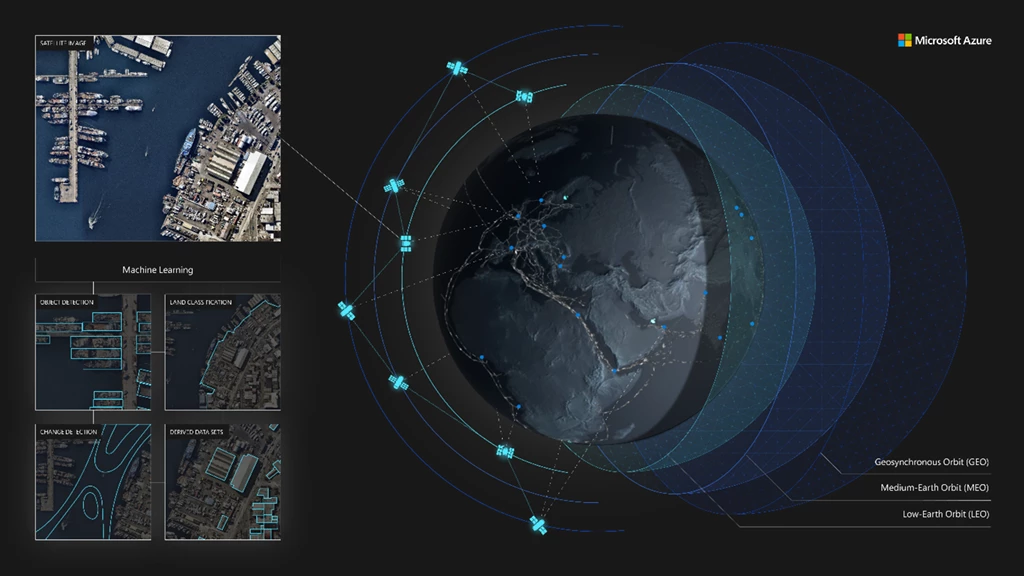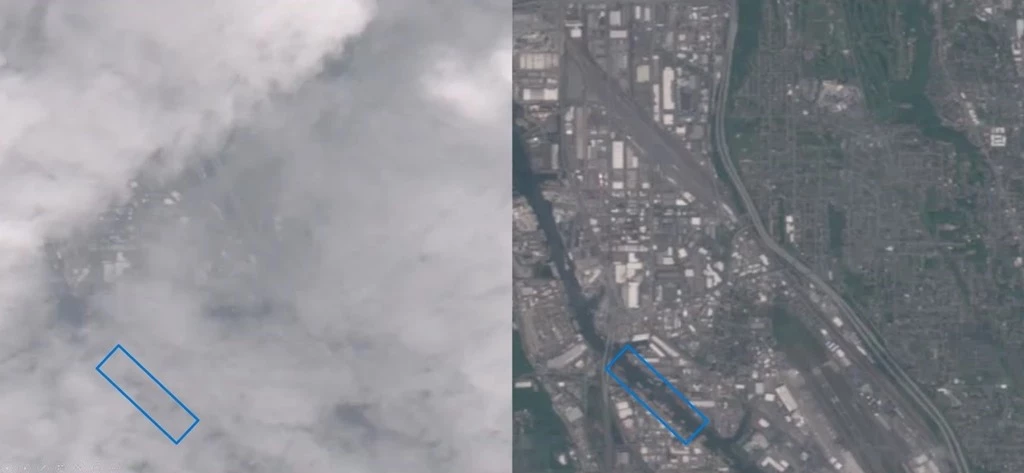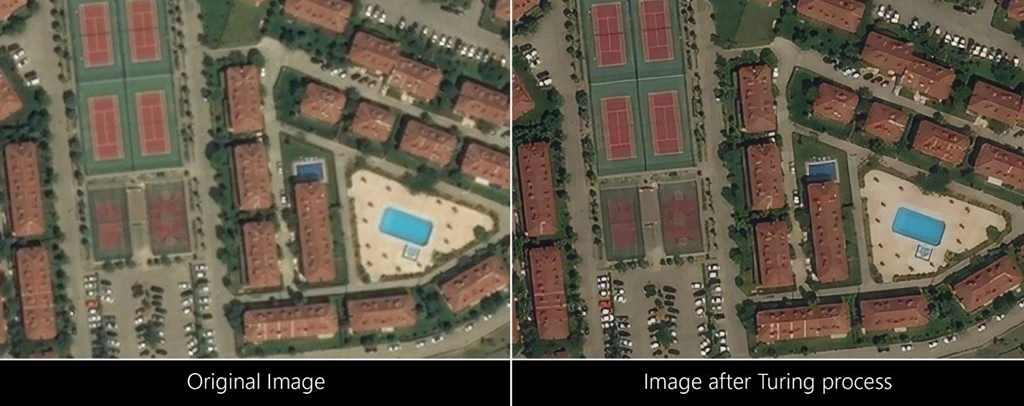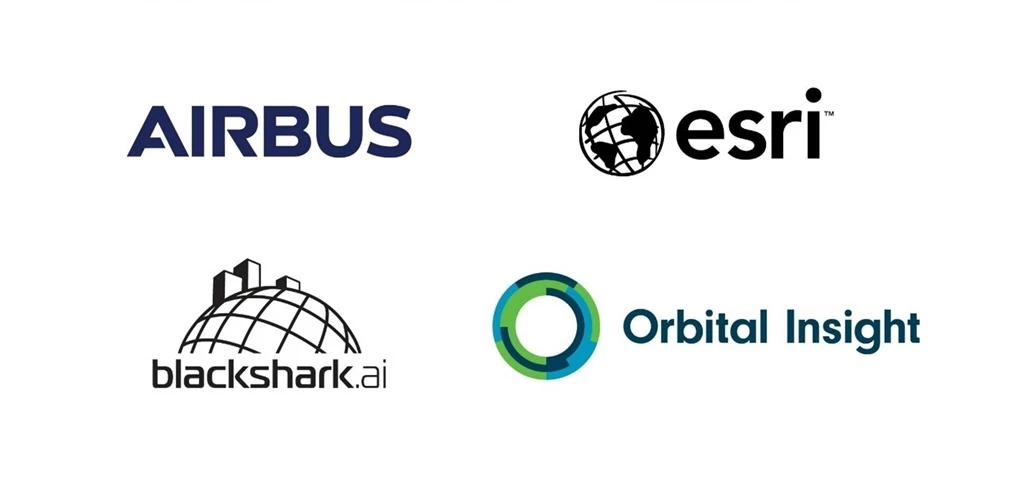Announcements, Azure Orbital Ground Station, Networking
New satellite connectivity and geospatial capabilities with Azure Space
Posted on
6 min read

Figure 1: Azure Space ecosystem showing multi-orbits and geospatial capabilities through Machine Learning.
Last year, Microsoft announced Azure Space, bringing together the possibilities of Space with the power of the cloud to help people and organizations achieve more on and off the planet.
Today we are announcing new partnerships and capabilities for Azure Space including:
- Azure Orbital reaches preview—now anyone can communicate and control satellites, from our owned and partnered ground-stations around the world—with no backhaul costs into Azure.
- Innovations built on Azure are “seeing” through the clouds with SpaceEye, and enhancing imagery with Project Turing.
- Our new partnership with Airbus is bringing the world’s leading high-resolution satellite imagery and elevation data into Azure, to further transform our understanding of the world.
- A virtualization partnership with iDirect, one of the largest satellite modem providers, is creating modern and flexible solutions for customers.
- New geospatial and data analytics partnerships with Esri, Blackshark.ai, and Orbital Insight on Azure are enabling new insights for our customers.
The power of extracting and leveraging data collected from space can transform entire industries and create new paradigms. Azure Space, through partnerships, space data, our collaboration tools, and Microsoft services and capabilities, unlock powerful possibilities for customers.
Manage Satellite Data at cloud scale with Azure Orbital

The need for low latency, high capacity ground infrastructure is becoming more critical as the public and private sectors launch large numbers of satellites and new constellations into space. Microsoft is bringing its world-leading ground infrastructure alongside partners to support this industry.
Microsoft is announcing the next milestone for Azure Orbital with the preview of a service that enables satellite operators to eliminate the technical, scheduling, and cost challenges of building a dedicated ground station network. The scale and scope of global ground stations through Azure Orbital and our partner network makes coverage more accessible for satellite providers at a lower cost, enabling high reliability and resiliency around the world ensuring support for any mission profile.
The Azure Orbital preview includes support for Microsoft and KSATlite ground stations. Starting this month, customers can use Azure Orbital APIs or the Azure Portal to communicate with their satellites using Microsoft and KSAT antennas. This network will continue to expand early next year with support for ground station partners ViaSat and USEI.
This significant step in the Microsoft and KSAT partnership allows customers to benefit from expansive global coverage free of the integration and data-delivery costs associated with typical multi-network solutions facilitating access to the power of the Microsoft Cloud to process, store, and extract insights from spaceborne data.
“Over the past year, we have worked hard here at KSAT to continue our collaboration with Azure Orbital integrating our worldwide satellite ground network with Microsoft to provide seamless, global support for transporting, processing, and storing space-based data. Being able to deliver satellite data and run resource-intensive computing such as machine learning techniques and other applications using cloud-based solutions will not only change the way we deliver our services but also how our customers will be able to utilize this information in the future. Through this partnership, our goal is to continue to provide our customers with the most technically advanced solutions for their missions”—Rolf Skatteboe, CEO KSAT
Learn more about Azure Orbital in this Microsoft Mechanics episode.
New innovations enhance satellite images through Azure

SpaceEye—“seeing” through the Clouds
67 percent of the world is covered in clouds—a major challenge for Earth observation from space is that much of the Earth is covered by opaque clouds. Built on Azure by Microsoft Research, SpaceEye is an AI-based system that generates daily cloud-free optical and multispectral imagery for the planet.
SpaceEye uses the Synthetic Aperture Radar (SAR) instrument from the Sentinel-1 mission as a baseline data source—as radar data is not affected by cloud cover. Space Eye then combines this radar data with historical optical imagery to generate an AI image prediction of what it looks under the clouds. This can unlock significant use cases in agriculture, land-use monitoring and disaster response among others.
Project Turing—increase human perception of overhead imagery

Microsoft Azure is also being used to prepare and enhance geospatial data for better human interoperability. Using Microsoft’s Turing research, we have brought the fictional “enhance image” feature from Hollywood to reality. Turing’s semantic super-resolution allows us to use satellite imagery and increase the resolution to be comparable to aerial, greatly aiding human perception of overhead imagery. Today, this technology is running on Azure to enhance Bing Maps worldwide, covering over 50 percent of all user requests.
View high-resolution satellite imagery of anywhere on the planet in partnership with Airbus
Microsoft is expanding on its mission to make Azure Space the platform and ecosystem of choice for the space community through a new partnership with Airbus and the general availability of their premium satellite imagery and elevation data in Microsoft Azure Maps. Through this partnership, Airbus will feed Azure Maps with its SPOT 1.5m, Pléiades 50cm, and Pléiades Neo 30cm resolution satellite imagery and WorldDEM4Ortho elevation data.
“We are thrilled to be a part of the Microsoft Azure community,” said François Lombard, director of the intelligence business at Airbus Defense and space. “Azure Maps users, eager for accurate and top-quality imagery, will be able to rely on Airbus’ premium data services to develop new applications and turn their innovative ideas into reality.”
Learn more about how geospatial imagery unlocks new cloud computing scenarios on Azure.
Virtualization brings a new era to Space connectivity
Traditionally, connectivity from a satellite to a ground station has depended on expensive and inflexible radio hardware. Azure Orbital takes advantage of virtualization, which moves functionality from proprietary hardware into software that can be deployed on general-purpose hardware to deliver a more scalable and cost-efficient solution for customers.
Another significant challenge for the space community is the lack of standardization. We are working with the industry through the Digital IF Interoperability (DIFI) consortium for which Microsoft is a founding board member to create standards to support the space ecosystem, such as the new IEEE-ISTO Std 4900-2021: Digital IF Interoperability Standard for streaming data between digitizers and virtualized modems. Together, virtualization and open standards enable customers to harness the power of the cloud to usher in a new era in the space industry.
Leveraging our Azure software radio tools for virtualized space and satellite communications (which are available on GitHub), Microsoft is excited to add ST Engineering iDirect, one of the most widely deployed and trusted satellite platforms, to our list of Azure Orbital ground segment partners. Through our development partnership, ST Engineering iDirect and Microsoft will collaborate to bring ST Engineering iDirect’s satcom solutions to Azure as virtualized modems that can be readily deployed and used by Azure Orbital customers. iDirect and Microsoft are transforming satellite ground stations into a fully virtualized digital platform enabling Satellite operators to achieve the economies of scale and software efficiencies of cloud scale operation.
Geospatial partnerships enable seamless analysis of space data on Azure

Today, we are also announcing new geospatial and data analytics partnerships with Esri, Blackshark.ai, and Orbital Insight on Azure enabling new insights for our customers.
Esri
Microsoft is teaming up with Esri—the global market leader in geographic information system software (GIS), location intelligence and mapping—to provide geospatial analytic workflows on spaceborne data natively to the Azure cloud.
“Microsoft continues to provide cloud innovation in support of partner opportunity enablement. Azure Orbital and Esri will streamline spaceborne data workflows to empower Azure customers with access to near-real time satellite data combined with Esri’s ArcGIS geospatial analytics software.”—Richard Cooke, VP, Esri, Imagery and Remote Sensing
Esri will bring ArcGIS Image, a dedicated single tenant SaaS offering, to Azure customers enabling end to end geospatial data management and analytics for near-real-time spaceborne data. ArcGIS Image for ArcGIS Online is a multi-tenant SaaS offering designed to help customers manage, interpret, analyze, and share imagery and derived insights from customers’ existing imagery data. Customers will be able to easily host imagery in the Azure cloud, eliminating the need to manage their own infrastructure, and perform advanced analytics on that data at scale.
Blackshark.ai
Microsoft and Blackshark.ai are partnering to bring Blackshark.ai’s advanced geospatial intelligence and 3D synthetic environments at scale to empower commercial and government customers with data, insights, and a digital twin of our planet on Microsoft Azure.
Orbital Insight
Additionally, Microsoft is partnering with Orbital Insight, a world-leading geospatial analytics software company that helps organizations understand what’s happening on and to the Earth, to make Orbital Insight GO platform available on Microsoft Azure. With GO on Azure, enterprises and governments can unlock insights on patterns of life, make supply chains visible, find anomalies, monitor facilities, and detect military movements, empowering decision-makers to act confidently.
Learn more
We continue to work to make space capabilities more accessible through collaboration and productivity tools available to customers around the world. We’re also working closely with an expanding partner ecosystem to help drive innovation on and off the planet. Through the combination of cloud and space capabilities, new sources of data are being collected, transported, and analyzed to rapidly drive new insights and understand the world around us. Learn more about Azure Space today.
We are excited to help organizations across industries re-imagine solutions to some of the world’s most challenging problems, support space missions off and on the planet, and harness the potential of cloud and space technologies, and look forward to meeting our industry peers to continue this discussion at next week’s World Satellite Business Week.